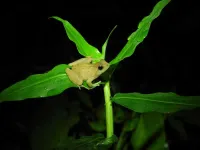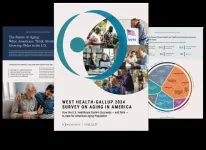(Press-News.org) Even widespread species could be genomically vulnerable to the climate crisis, scientists warn. By studying the DNA of puddle frogs living in central African rainforests, the scientists found that areas of high environmental variation foster high genetic variation. If these varied habitats and the frogs that live there are lost, genetic variants that could have allowed the species to evolve to survive the climate crisis could be lost too. Meanwhile, populations with low genetic variation could become extinct quickly, unable to adapt.
“Generally, the more genomic variation within a population, the more likely they will be able to respond to changes in their environment, such as future climate change,” said Dr Courtney Miller of the University of New Orleans, lead author of the study in Frontiers in Conservation Science.
“We wanted to identify drivers of genomic variation and how populations might respond to future climate change,” added Dr Geraud Tasse Taboue of the University of Buea, second author.
Survival of the fittest
The climate crisis is expected to change the face of the world very rapidly. If animals can’t find suitable habitats, they will need to adapt, either by evolving or by making behavioral changes. The more genetic diversity in a species, the more likely it can successfully evolve to survive.
The tropical forests of the Gulf of Guinea and the Congo Basin are predicted to be particularly seriously affected by the climate crisis. These forests are also biodiversity hotspots. Several factors could contribute to this, by separating populations of a species from each other so that they become more distinct over time: distance, physical barriers like large rivers, environmental variation, and fragmentation of the forest during the Pleistocene. A widespread species like puddle frogs makes an ideal model for unravelling the impact of these factors on genetic variation, which is critical to understanding species’ genomic vulnerability — how likely it is that they will be able to adapt evolutionarily to climate change.
The scientists sampled 191 frogs across a range of different locations and habitats, extracting DNA and mapping the occurrence of different variants. They then used environmental variables linked to the frogs’ biology and behavior to map differences between the frogs’ habitats: the annual temperature and rainfall and how much these varied across the year, and the amount of precipitation in the coldest quarter of the year. They used projections of how these variables will change with the climate crisis to model the frogs’ future habitat. They also used models of the past climate to understand how habitat availability in the Pleistocene could affect present-day variation.
Habitat hotspots
Combining this data and analyzing it with specialized statistical methods allowed the scientists to identify the most important forces in driving the puddle frogs’ genetic variation and to determine areas where the frogs would be more genomically vulnerable. The team found that for puddle frogs, genetic variation was influenced by the distance between sites but primarily predicted by their environment. Seasonal patterns of precipitation were particularly influential. Landscapes with multiple types of habitat in close proximity also overlapped with areas of high genetic variation.
“Variation in precipitation is the main factor in environmentally-associated genomic variation for this frog,” said Miller. “Frogs that occur within the Cameroonian highlands, the forest-savanna ecotone of south-central Cameroon, across the equator, and from the coast to the interior of Gabon may be more likely to keep pace with future climate change.”
The scientists also identified several areas where frog populations may not have enough genetic variation to be able to adapt to abrupt habitat changes — for example, in southwest Gabon.
The team suggests that these findings, and similar research on different species, could be useful for planning conservation interventions. However, the scientists caution that their analysis only partially captures the frogs’ genetic variation, and that to fully understand the impact of these variants on puddle frogs’ future survival we’ll need to link them to phenotypic traits.
“We weren’t able to identify variants under selection, which might have provided additional insight on adaptive potential,” said Tasse Taboue. “But conservation efforts could focus on preserving areas with high genomic variation, under the assumption that these areas harbor individuals that may be more likely to persist given environmental change.”
END
Tiny tropical puddle frogs show that protecting genetic variation is essential for animals to survive the climate crisis
Scientists studied puddle frogs to identify genetic variation hotspots and places where the climate crisis could wipe out populations too homogenous to adapt
2024-06-05
ELSE PRESS RELEASES FROM THIS DATE:
3 in 4 Americans under 65 are worried about future of Medicare
2024-06-05
WASHINGTON, D.C. — June 5, 2024 — Concerns over the potential insolvency of Medicare among those under 65 have risen, with 73% now expressing worry that it won’t be available when they need it, up from 67% in 2022, according to the new West Health-Gallup 2024 Survey on Aging in America. Worry rose most amongst those aged 50 to 64, up 13 percentage points to 74%. Higher percentages of adult’s express concern about the future of Social Security, with 80% of people under 62 and 86% of people aged 40 to 49 fearing it will not be around once they are eligible.
According ...
Gold nanoparticles that selectively emit left-/right-handed light
2024-06-05
doi.org/10.1002/adom.202400699When chiral(1) gold nanoparticles(2) are irradiated with near-infrared(3) femtosecond pulses(4), visible emission of luminescence is observed. In this study, this luminescence was found to yield high selectivity for left- or right-handed circularly polarized(5) light, depending on the chirality of the nanoparticles, with a dissymmetry factor(6) of approximately 0.7. This finding suggests the potential to elevate various applications using circularly polarized light to practical levels.
Abstruct
The research group led by Project Assistant Professor Dr. Hyo-Yong AHN, ...
New AI algorithm detects rare epileptic seizures
2024-06-05
More than 3.4 million people in the US and 65 million people worldwide have epilepsy, a neurological disorder that affects the nervous system and causes seizures. One in 26 people will develop epilepsy at some point in their lives, and 1 out of 1000 people with epilepsy die from unexpected deaths each year.
Like many conditions, epilepsy treatment starts with early detection. The World Health Organization estimates that 70% of people with epilepsy could live seizure-free if adequately diagnosed and treated.
Over the years, ...
People underestimate the probability of including at least one minority member in a group
2024-06-05
Niigata, Japan - Human society includes various minority groups. However, it is often difficult to know whether someone is a minority member simply by looking at the person, as minority traits may not be visually apparent (e.g., sexual orientation, color vision deficiency). In addition, minorities may hide their minority traits or identities. Consequently, we may have been unaware of the presence of minorities in daily life. Probabilistic thinking is critical in such uncertain situations. The people with whom we interact in our daily lives are typically a group of several dozen individuals (e.g., a school class). How do we judge the probability of including at least one minority ...
Celebrate Pride Month by learning CPR. The life you save may be someone you love
2024-06-05
DALLAS, June 4, 2024 — According to the American Heart Association, when someone suffers a cardiac arrest, immediate cardiopulmonary resuscitation (CPR) is critical and can double or triple a person’s chance of survival. More than 350,000 out-of-hospital cardiac arrests occur in the United States each year. Of those, 90% will not survive, according to the Association, which is working to turn more bystanders into lifesavers who can use CPR in an emergency. The American Heart Association, celebrating one hundred years of lifesaving service as a global ...
Dr. Erin Belval honored for exemplary fire science research
2024-06-05
FORT COLLINS, Colo., June 4, 2024 — Dr. Erin Belval, a research forester at the USDA Forest Service Rocky Mountain Research Station, was awarded the Early Career Scientist Award in Fire Science from the International Association of Wildland Fire (IAWF). She received the honor last month at the 2024 International Wildland Fire Conference in Boise, Idaho.
The award recognizes promising early-career professionals who demonstrate outstanding ability in any field of wildland fire science. Belval was nominated by colleagues and peers for her outstanding contributions.
“The award is particularly meaningful because ...
A novel approach to tracking conservation reveals more areas may be conserved than currently accounted for
2024-06-05
(Santa Barbara, Calif.) — Thirty by thirty. It’s an ambitious answer to growing calls for protecting more of our planet’s surface. The goal is to conserve 30% of the Earth’s oceans, lands and freshwaters by 2030. While this may seem a lofty aim, the diversity and coverage of conservation areas today might be greater than what’s currently recognized by global tracking systems.
An international team of conservation researchers and practitioners, led by scientists at UC Santa Barbara and The Nature Conservancy, has developed an inclusive inventory approach for tracking ...
Commonly used alcohol-based mouthwash brand disrupts the balance of your oral microbiome, scientists say
2024-06-05
SUMMARY
Researchers have identified a significant change in composition and abundance of bacteria in study participants’ oral microbiomes after using a popular brand of alcohol-based mouthwash.
The oral microbiome is the community of bacteria that live in the mouth, they help us digest our food and keep our mouth healthy.
Researchers found that two species of opportunistic bacteria were significantly more abundant in the mouth after daily use of the alcohol-based mouthwash, Fusobacterium nucleatum and Streptococcus anginosus. ...
Injury prediction rule could decrease radiographic imaging exposure in children, study shows
2024-06-05
(COLUMBUS, Ohio) – While cervical spine injuries (CSI) are uncommon in children, they can be potentially devastating, resulting in quadriplegia – paralysis below the neck affecting both arms and both legs. Detecting CSIs in a clinical setting often requires imaging such as X-rays and computed tomography (CT) scans, both of which expose children to radiation, which can cause other health issues over time.
In a study published today in The Lancet Child & Adolescent Health, researchers in the Pediatric Emergency Care Applied Research Network (PECARN) – led by Julie Leonard, MD, MPH at Nationwide Children’s Hospital –created a highly accurate ...
Rate of global warming caused by humans at an all-time high say scientists
2024-06-05
University of Leeds press release
UNDER EMBARGO UNTIL 00.01 UK BST, 5 JUNE 2024 (19.01 US ET, 4 JUNE 2024)
The second annual Indicators of Global Climate Change report, which is led by the University of Leeds, reveals that human-induced warming has risen to 1.19 °C over the past decade (2014-2023) – an increase from the 1.14 °C seen in 2013-2022 (set out in last year’s report).
Looking at 2023 in isolation, warming caused by human activity reached 1.3 °C. This ...
LAST 30 PRESS RELEASES:
Tracing the quick synthesis of an industrially important catalyst
New software sheds light on cancer’s hidden genetic networks
UT Health San Antonio awarded $3 million in CPRIT grants to bolster cancer research and prevention efforts in South Texas
Third symposium spotlights global challenge of new contaminants in China’s fight against pollution
From straw to soil harmony: International team reveals how biochar supercharges carbon-smart farming
Myeloma: How AI is redrawing the map of cancer care
Manhattan E. Charurat, Ph.D., MHS invested as the Homer and Martha Gudelsky Distinguished Professor in Medicine at the University of Maryland School of Medicine
Insilico Medicine’s Pharma.AI Q4 Winter Launch Recap: Revolutionizing drug discovery with cutting-edge AI innovations, accelerating the path to pharmaceutical superintelligence
Nanoplastics have diet-dependent impacts on digestive system health
Brain neuron death occurs throughout life and increases with age, a natural human protein drug may halt neuron death in Alzheimer’s disease
SPIE and CLP announce the recipients of the 2025 Advanced Photonics Young Innovator Award
Lessons from the Caldor Fire’s Christmas Valley ‘Miracle’
Ant societies rose by trading individual protection for collective power
Research reveals how ancient viral DNA shapes early embryonic development
A molecular gatekeeper that controls protein synthesis
New ‘cloaking device’ concept to shield sensitive tech from magnetic fields
Researchers show impact of mountain building and climate change on alpine biodiversity
Study models the transition from Neanderthals to modern humans in Europe
University of Phoenix College of Doctoral Studies releases white paper on AI-driven skilling to reduce burnout and restore worker autonomy
AIs fail at the game of visual “telephone”
The levers for a sustainable food system
Potential changes in US homelessness by ending federal support for housing first programs
Vulnerability of large language models to prompt injection when providing medical advice
Researchers develop new system for high-energy-density, long-life, multi-electron transfer bromine-based flow batteries
Ending federal support for housing first programs could increase U.S. homelessness by 5% in one year, new JAMA study finds
New research uncovers molecular ‘safety switch’ shielding cancers from immune attack
Bacteria resisting viral infection can still sink carbon to ocean floor
Younger biological age may increase depression risk in older women during COVID-19
Bharat Innovates 2026 National Basecamp Showcases India’s Most Promising Deep-Tech Ventures
Here’s what determines whether your income level rises or falls
[Press-News.org] Tiny tropical puddle frogs show that protecting genetic variation is essential for animals to survive the climate crisisScientists studied puddle frogs to identify genetic variation hotspots and places where the climate crisis could wipe out populations too homogenous to adapt






